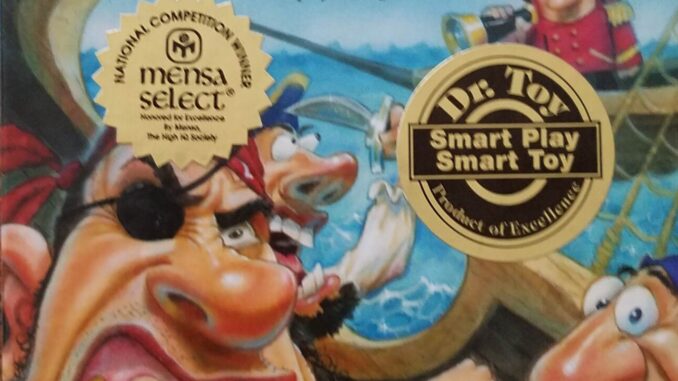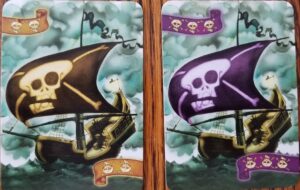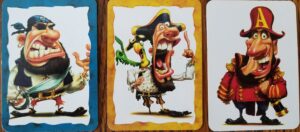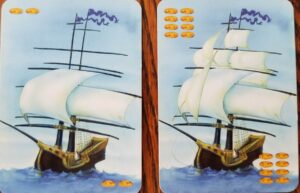
We’ve had Loot sitting on our shelves for years. I can’t remember when we got it. I know we tried it out at some point but it must have been before the kid was born. Short review, it’s not a great two player game. But we’ve been having lots of fun with other Gamewright games so pulled it out to try again. With 3+ playing, how’s it stack up?
Gameplay- B+
 The theme of the game is simple; you’re pirates looting ships for treasure. On your turn you get to take one action (play a card, draw a card, discard a card) and then draw a card. Your goal is to collect the most treasure which comes in the form of merchant ships. You can play merchant ships or you can play pirate ships to steal other player’s merchants or protect your own merchants. Each merchant ship card has a treasure value from two to eight and pirate ships have an attack value of one to four. There are four colors of pirates and once you play a color on a merchant, no one else can play that color.
The theme of the game is simple; you’re pirates looting ships for treasure. On your turn you get to take one action (play a card, draw a card, discard a card) and then draw a card. Your goal is to collect the most treasure which comes in the form of merchant ships. You can play merchant ships or you can play pirate ships to steal other player’s merchants or protect your own merchants. Each merchant ship card has a treasure value from two to eight and pirate ships have an attack value of one to four. There are four colors of pirates and once you play a color on a merchant, no one else can play that color.
Determining who collects a merchant ship is based on the last card played. If you play a merchant, and it gets back around to your turn with no one playing a pirate ship on it, you collect the ship as loot. If anyone plays a pirate ship on it, everyone else, including the person who originally played the merchant ship, has a chance to play pirates of equal or greater strength.
Example, I play a merchant ship of treasure four. Then Player Two plays a pirate ship of value two on the merchant. No other player plays anything. It gets back to my turn. If I play a pirate of value 2+ then Player Two will have a chance to beat me. This back and forth continues until someone fails to beat or there’s a tie. A tie remains in play until someone plays more. You can play as many pirates on a single merchant but only one at a time. So Player One and Two could go back and forth for four rounds continuing to one up each other, and meanwhile Player Three is playing Merchant ships for themselves and they are going uncontested.

The final card types are Pirate Captains and the Admiral. There is one Pirate Captain for each color (purple, blue, gold, green) and a single Admiral. These cards work like pirate ships of Infinite value. If Player One plays a Pirate Captain, only another Pirate Captain can beat it. You must have played that pirate’s color previously before you can play the Captain. The Admiral can only be played for defense by the player who played the Merchant ship and they can play it without having played any pirate ships. If two of these special cards are played, the winner is the last one played.
The game ends when the deck is empty and one player plays their last card. This often means there are unclaimed merchant ships left on the board. Then you add up the treasure you collected, subtract any merchant ships left in your hand, and see who wins.
Production- A
The cards are sturdy and the box comes with a plastic piece that fits the deck perfectly. The instructions are short and clear.
As a nice touch, the merchant ship’s treasure value is reflected in their artwork. The more sails, the greater the value. This makes determining the value of a ship easier from a distance as the actual gold coin symbols can be hard to count at a glance once you get past three.
Theme- A

You’re a bloody pirate. Well, not so bloody, this is a family game. But you do plenty of stealing. So the theme matches the mechanics.
The card artwork is effective if not inspired. Aside from the increased sails for merchant ships of different values, each card uses the same art. Each pirate ship is identical aside from color and number of skulls, representing strength. The pirate captains each have a unique look though.
Expansions- N/A
None I am aware of. There is a Deluxe Tin version of the game with different artwork.
Conclusion- B+
A fun, quick, lunch time game for the whole family. You don’t have to overthink it to play but you can, to good effect. It does encourage you to think logically and through the consequences of each action. Do you keep fighting for a ship, or try to slip your merchant through while others are fighting over a higher value? Do you draw an extra card to increase the chance of getting a captain? Which captains are still out there?
The more players the better, it is though. Two isn’t worth playing. Three is better but can easily let one player run away with the game if the other two get too focused on winning a particular ship.


